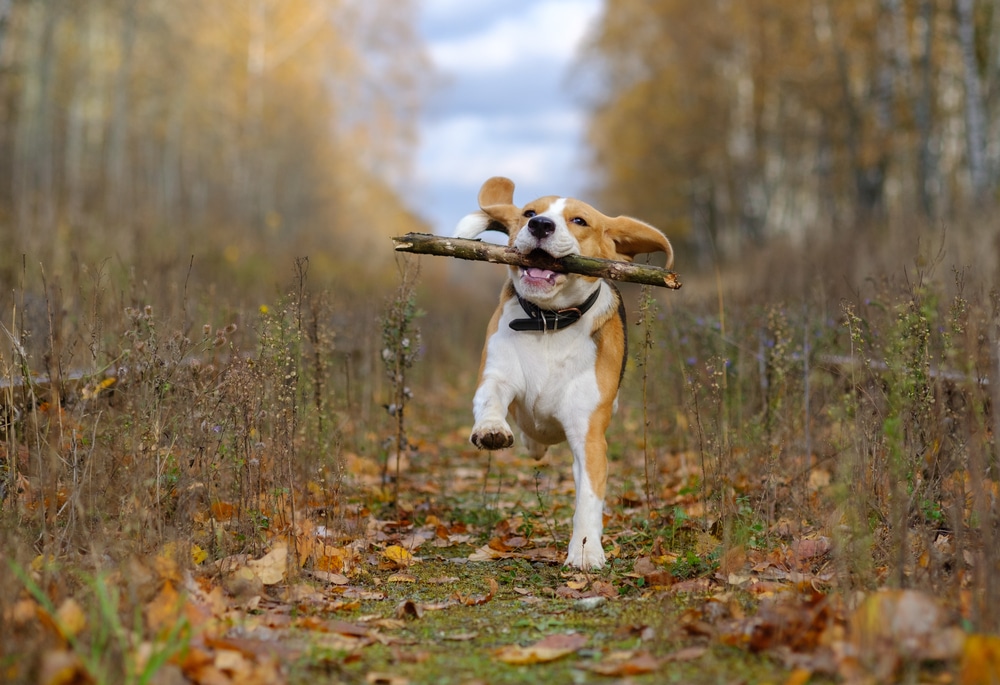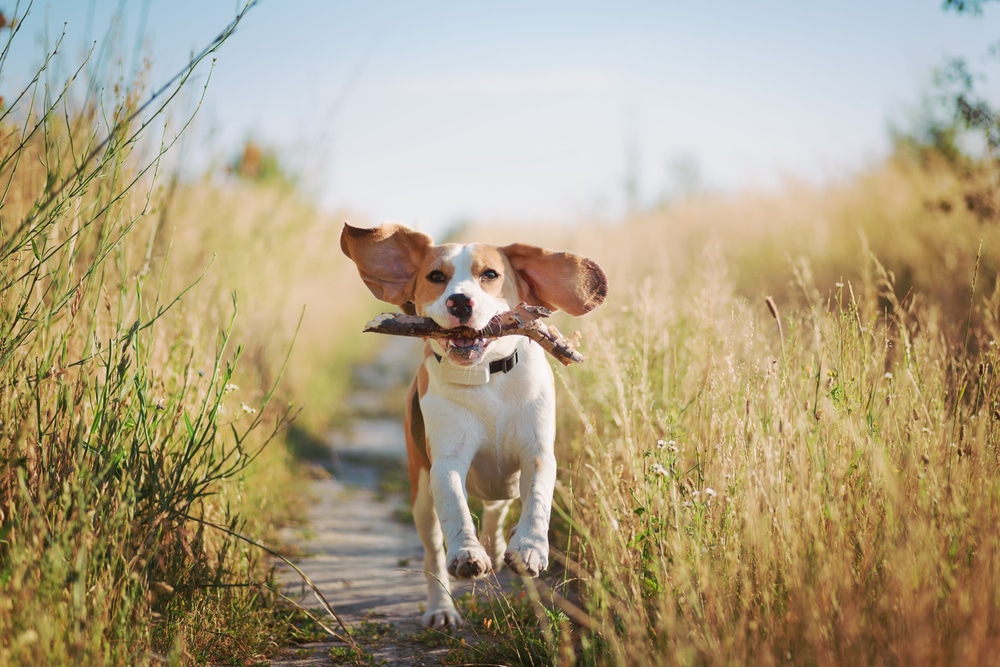Dogs love to chew on anything, from shoes and furniture to sticks and rocks. So, the question arises: is it safe for dogs to eat sticks? While it may seem harmless enough, pet parents should be aware there could be some risks involved when their dogs tries to eat sticks.
Dogs should not chew on sticks as it poses various hazards to their health. It can cause injuries to the mouth, throat, or digestive tract. Large pieces of wood can cause blockages in the intestines or stomach, leading to severe health issues. Some types of wood can be toxic to dogs, and some may lead to allergic reactions.
Table of Contents
Why Dogs Should Not Chew On Sticks
Dogs, like humans, can get injured from chewing on sticks. Wood splinters can get lodged in the mouth and throat, causing discomfort or infection.
Additionally, many sticks contain toxic substances that may be absorbed into the bloodstream when chewed. These toxins could cause serious health problems for your furry friend.
Sharp edges of the sticks can cause cuts or lacerations in your pet’s mouth and gums, which can be painful and difficult to heal as well.
Given these potential risks, it is best to avoid allowing your pet to chew on sticks. If you must, it is essential to supervise your pet and ensure that the sticks are of a suitable size and free from sharp edges or dangerous substances.
Toys designed for chewing are also available for purchase, so you can provide an appropriate outlet for your dog’s natural urge to chew.
Potential Hazards Of Eating Sticks For Dogs
Potential hazards of eating sticks for dogs include the following.
Mouth Or Throat Injuries
One of the major potential hazards of eating sticks for dogs is mouth and throat injuries. The sharp edges of a stick can easily cause cuts to the tongue, gums, or other parts of the oral cavity.
Moreover, if a stick too large for your dog’s throat is eaten, it may become lodged in its esophagus and cause choking.
Blockage In The Digestive System
One of the potential hazards of feeding sticks to dogs is that it can cause a blockage in their digestive system.
This is especially true for smaller breeds, as they have narrower throats and intestines than larger breeds. Stick pieces can get lodged in your dog’s throat or intestine, leading to pain and discomfort.
If this occurs, it can lead to serious health problems, such as malnutrition and even death. If your dog does become blocked, seek emergency veterinary care immediately.
Risk Of Toxicity
Sticks can contain toxic chemicals from automotive exhaust, pesticides, and herbicides. Ingesting these chemicals can lead to various health issues, including vomiting, diarrhea, abdominal pain, loss of appetite, seizures, and even organ failure.
As such, it is important to avoid letting your dog eat sticks that may have been exposed to these hazardous chemicals.
Allergic Reactions
Eating sticks can cause an allergic reaction in some dogs. Dogs can be allergic to the type of wood or even the bark and leaves of trees.
These reactions may lead to vomiting, diarrhea, hives, itching, and other symptoms. It’s important to watch your dog closely after they ingest a stick, as these reactions could require medical attention.
If a stick is splintered, it can cause serious internal damage to your dog and create an open wound that is vulnerable to infection.
Signs Your Dog Has Eaten A Stick
If you suspect your pup has eaten a stick, it’s essential to watch out for the following signs.
Abnormal Drooling Or Vomiting
If your dog is drooling more than usual, it might have an obstruction in its throat caused by the stick. Additionally, if they are vomiting frequently and unable to keep down food, this could indicate the stick is causing a blockage in their digestive tract.
Decreased Appetite Or Refusal Of Water
If your pup has ingested a stick and it’s blocking its stomach, it may not have the urge to eat or drink due to discomfort.
Pain Or Blood In The Stool
If the stick has been partially digested, it may cause your pup to pass blood in their stool or exhibit extreme discomfort when defecating.
Coughing/Wheezing/Gagging
If the stick is stuck in your pup’s throat, it may have difficulty breathing or swallowing. This can result in coughing, gagging, or wheezing.
What To Do If Your Dog Has Eaten A Stick
If your dog has eaten a stick, you should seek medical attention immediately. Your veterinarian will want to take x-rays of your pup’s abdomen to determine if the stick has become lodged in their digestive tract or is causing blockages.
Depending on the size and shape of the stick, it may cause damage internally as it moves through the digestive tract too.
If the stick is visible on the x-ray, your veterinarian can discuss options for removing it or breaking it into smaller pieces that can pass through your dog’s system safely.
In some cases, surgery may be necessary to remove a large, sharp, or otherwise difficult-to-pass stick from the intestine.
How To Stop Your Dog From Eating Sticks

Start by removing the sticks from your dog’s environment. This includes sticks in the yard, sticks on walks and at parks, and any other places your pup might find a stick to eat.
Provide distractions for your dog when they’re outdoors. Bring along toys or treats that can help keep its attention off the sticks.
Teach your dog the, “Leave it,” command too. This will help them learn to ignore objects, such as sticks, when you tell them to do so.
Monitor your dog closely when outdoors, and look for signs that they may be about to pick up a stick or other item.
Alternatives To Dogs Eating Sticks
Here’s what they are.
Raw Vegetables
Vegetables like carrots and broccoli provide a texture your dog will enjoy, and they are packed with vitamins, minerals, and fiber.
Fruits
Fruits like apples provide healthy natural sugars for dogs and a crunchy texture too.
Homemade Dog Treats
Homemade treats can be made from ingredients such as oats, peanut butter, and bananas.
Dried Meat
Dried meats like beef jerky and turkey jerky provide a crunchy texture and are also high in protein. Just make sure they don’t have any additional herbs, spices, or other additives that don’t agree with or are toxic to dogs.
Kibble-Coated Treats
Treats coated with kibble offer a crunchy texture and are packed with nutrients.
In Conclusion: Can Dogs Eat Sticks?
Sticks present a serious risk of internal damage to our canine companions, so it’s essential to watch for signs of distress or discomfort and seek medical attention if necessary. To prevent accidental ingestion, make sure all possible sources are removed from their environment and provide alternative distractions when outdoors.
So, are you concerned your dog will try to eat sticks? What do you plan to do to stop them? Let us know in the comments below!
